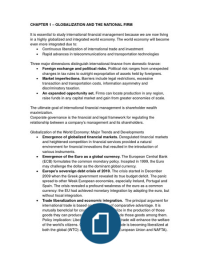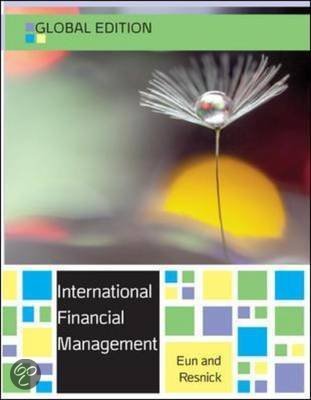CHAPTER 1 – GLOBALIZATION AND THE NATIONAL FIRM
It is essential to study international financial management because we are now living
in a highly globalized and integrated world economy. The world economy will become
even more integrated due to:
Continuous liberalization of international trade and investment
Rapid advances in telecommunications and transportation technologies
Three major dimensions distinguish international finance from domestic finance:
Foreign exchange and political risks. Political risk ranges from unexpected
changes in tax rules to outright expropriation of assets held by foreigners.
Market imperfections. Barriers include legal restrictions, excessive
transaction and transportation costs, information asymmetry and
discriminatory taxation.
An expanded opportunity set. Firms can locate production in any region,
raise funds in any capital market and gain from greater economies of scale.
The ultimate goal of international financial management is shareholder wealth
maximization.
Corporate governance is the financial and legal framework for regulating the
relationship between a company’s management and its shareholders.
Globalization of the World Economy: Major Trends and Developments
Emergence of globalized financial markets. Deregulated financial markets
and heightened competition in financial services provided a natural
environment for financial innovations that resulted in the introduction of
various instruments.
Emergence of the Euro as a global currency. The European Central Bank
(ECB) formulates the common monetary policy. Incepted in 1999, the Euro
may challenge the dollar as the dominant global currency.
Europe’s sovereign debt crisis of 2010. The crisis started in December
2009 when the Greek government revealed its true budget deficit. The panic
spread to other Weak European economies, especially Ireland, Portugal and
Spain. The crisis revealed a profound weakness of the euro as a common
currency: the EU had achieved monetary integration by adopting the euro, but
without fiscal integration.
Trade liberalization and economic integration. The principal argument for
international trade is based on the theory of comparative advantage. It is
mutually beneficial for countries if they specialize in the production of those
goods they can produce most efficiently and trade those goods among them.
Policy implication: Liberalization of international trade will enhance the welfare
of the world’s citizens. Currently, international trade is becoming liberalized at
both the global (WTO) and the regional levels (European Union and NAFTA).
, Privatization. Through privatization, a country divests itself of the ownership
and operation of a business venture by turning it over to the free market
system.
Global financial crisis of 2008-2009. The subprime mortgage crisis in the
US led to a severe credit crunch and escalated to a full-blown global crisis.
Causes of the crisis:
- Excessive borrowing and risk taking by households and financial
institutions.
- The crisis was amplified manifold and transmitted globally by
securitization (allowing loan originators to avoid bearing the default risk).
- The ‘invisible hands’ of free markets apparently failed to self-regulate its
excesses.
- International financial markets are highly interconnected and integrated
nowadays.
Growing role of MNCs in the world economy
A multinational corporation (MNC) is a business firm incorporated in one country that
has production and sales operations in many other countries.
MNCs may gain from their global presence in a variety of ways:
Benefit from the economy of scale by:
- spreading R&D expenditures and advertising costs over global sales
- pooling global purchasing power over suppliers
- utilizing technological and managerial know-hog globally with minimum
additional costs
Take advantage of underpriced labor services (e.g. outsourcing of production)
and special R&D capabilities in advanced countries.
CHAPTER 2 – INTERNATIONAL MONETARY SYSTEM (background reading)
The international monetary system can be defined as the institutional framework
within which international payments are made, movements of capita are
accommodated and exchange rates among currencies are determined.
The European Union has pursued Europe-wide monetary integration by first
establishing the European Monetary System and later the European Monetary Union.
In 1979, the EEC countries launched the European Monetary System (EMS) to
establish a ‘’zone monetary stability’’ in Europe. The two main instruments of the
EMS are the European Currency Unit (ECU) and the Exchange Rate Mechanism
(ERM). The ECU is a basket currency comprising the currencies of the EMS
members and serves as the accounting unit of the EMS. The ERM refers to the
procedure by which EMS members collectively manage their exchange rates. The
ERM is based on a parity grid that the member countries are required to maintain.
,On January 1st 1999 11 European countries adopted a common currency: the euro.
The euro may eventually rival the US dollar as a global vehicle currency. Euro zone
countries will benefit from reduced transaction costs and the elimination of exchange
rate uncertainty. The advent of the euro will also help develop continent-wide capital
markets where companies can raise capital at favorable rates.
Under the European Monetary Union (EMU), the European Central Bank (ECB)
formulates the common monetary policy for the euro zone countries. The ECB is
legally mandated to maintain price stability in Europe. Together with the ECB, the
national central banks of the euro zone countries from the Eurosystem, which is
responsible for defining and implementing the common monetary policy for the EMU.
CHAPTER 5 – THE MARKET OF FOREIGN EXCHANGE
The foreign exchange (FX) market encompasses the conversion of purchasing power
from one currency into another, bank deposits of foreign currency, the extension of
credit denominated in a foreign currency, foreign trade financing, trading in foreign
currency options and futures contracts, and currency swaps.
The FX market is the largest and most active financial market in the world.
The spot and forward foreign exchange markets are over-the-counter (OTC) markets;
that is, trading does not take place in a central marketplace where buyers and sellers
congregate.
The FX market is divided into two tiers:
Retail or client market; where international banks service their customers
who need foreign exchange to conduct international commerce or trade in
international financial assets.
Wholesale or interbank market; great majority of FX trading takes place
among international banks that are adjusting inventory positions or conducting
speculative and arbitrage trades.
The FX market participants include:
International banks; provide the core of the FX market.
Bank customers; include MNCs, money managers, and private speculators.
Nonbank FX dealers; large nonbank financial institutions such as investment
banks, mutual funds, pension funds, and hedge funds.
FX brokers; match dealer orders to buy and sell currencies for a fee, but do
not take a position themselves.
, Central banks; national monetary authorities. Intervention is the process of
using foreign currency reserves to buy one’s own currency in order to
decrease its supply and thus increasing its value in the foreign exchange
market, or alternatively, selling to increase supply and lower its price.
Three major market segments:
Australasia
Europe
North America
The interbank market is a network of correspondent banking relationships, with large
commercial banks maintaining demand deposit accounts with one another.
The spot market
In the spot market for FX, nearly immediate purchase and sale of currencies take
place. Spot rate currency quotations can be stated in direct or indirect terms, that is,
the price of one US dollar in the foreign currency (from US perspective).
European terms quote the US dollar in terms of the foreign currency (an indirect
quote from the US perspective).
By convention, it is standard practice to price currencies in terms of the Us dollar, so
in American terms.
Notation as used in the textbook: S(j/k) refers to the price of one unit of currency k in
terms of currency j.
American and European term quotes are reciprocals:
1
S ( $/ £)=
S(£ /$)
Cross-exchange rate is an exchange rate between a currency pair where neither is
the US dollar:
S( $ /£ )
S ( € / £)=
S( $ /€ )
In general terms: S(j/k) = S($/k) x S(j/$)
Interbank FX traders buy currency for inventory at the bid price and sell from
inventory at the higher offer or ask price.
Reciprocal relationship between European and American term quotations:
1
S a ($/ £)= b
S ( £ /$ )
When considering the a bid-ask quote $1.5400-$1505, the 1.54 is considered the big
figure and the second two digits are the small figure.
A non-dollar trade is referred to as a currency against currency trade.
The bank will quote the following bid price recognizing transaction costs:






